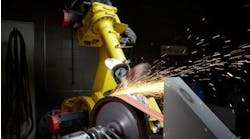Lawrence Livermore National LaboratoryLivermore, Calif.
Just when you thought we might be reaching some kind of limit in our ability to cram functionality onto a computer chip, Lawrence Livermore National Labs (LLNL) and its technology partners have come up with a breakthrough that could yield a quantum leap in chip capacity. "With a lithography process using extreme ultraviolet light [EUV], manufacturers should be able to produce computer chips 10 times faster and with 1,000 times more memory that today's chips," says Nat Ceglio, head of LLNL's Advanced Microtechnology Program (AMP). Lithography is the technique for mass-producing images and patterns on the chip substrates. Current state-of-the-art ultraviolet-light lithography uses light with wavelengths 20 times longer than the EUV process. Feature-size line widths on the chips can be reduced from 0.35 microns down to 0.1 microns with the EUV technique (one micron is one millionth of a meter). Announced in July, LLNL had to overcome two critical hurdles to make the EUV lithography process a success: cutting mask defects and improving the accuracy of components used in the process itself. "Masks are the Achilles heel for all advanced lithography systems," says Don Kania, deputy AMP leader at LLNL. So together with partner Veeco Instruments Inc., Plainview, N.Y., the lab developed an ion-sputtering device that provides a 300,000-fold reduction in the number of defects for the multilayer coated reflective masks used to transfer circuit patterns onto silicon wafers or chips. "We expect to commercialize this ultra-clean, low-defect, low-particulate ion-beam sputtering system for early 1997 availability," says Emmanuel Lekios, vice president and general manager of Veeco's Ion Beam Group. The IBD-350 system will be marketed for critical mask and semiconductor applications and to thin-film magnetic-head companies. The second advance was a critical 20- to 50-fold improvement in accuracy for measuring the surface shapes of optical components used in the lithography process. "This great leap forward will allow firms to make optics the size of a dinner plate to a billionth of a meter accuracy," says Kania. Today's commercial instruments for measuring surface shapes, called interferometers, are accurate to between 1/20 to 1/50 the width of a wavelength of visible light. The new instrument has accuracy pegged at 1/1,000 of a wavelength of visible light. "However, for EUV to be a commercial success, that has to be improved to 1/2,000 of a wave length of light," says Gary Sommargren, LLNL optical physicist and inventor of the device. Now in its fourth year, the EUV pact has received $30 million in funding from the Dept. of Energy, plus $30 million of in-kind contributions from the partnership of eight microelectronics firms, including AT&T Corp., Murray Hill, N.J.; Intel Corp., Santa Clara, Calif.; Advanced Micro Devices Inc., Sunnyvale, Calif.; and KLA Instruments Corp., San Jose. Two other national labs -- Sandia and Lawrence Berkeley -- also participate in the project.



